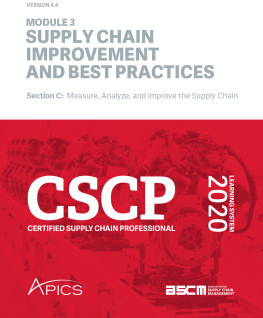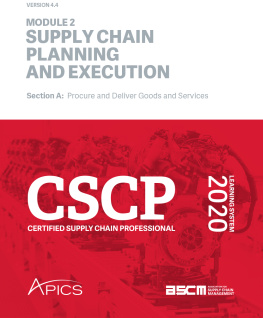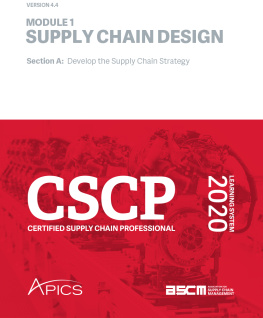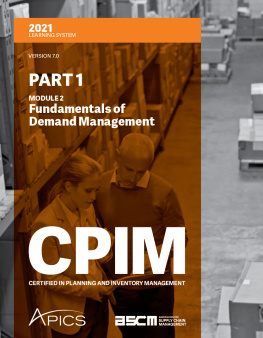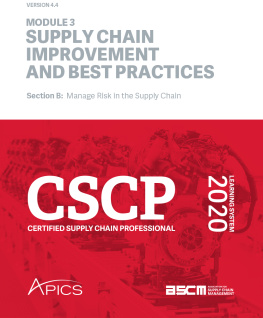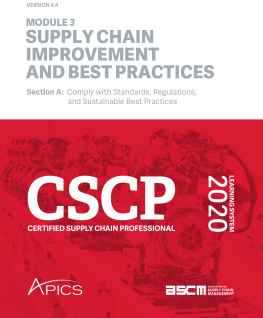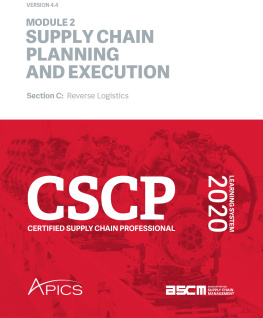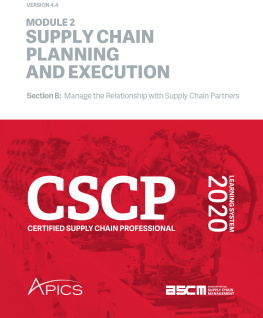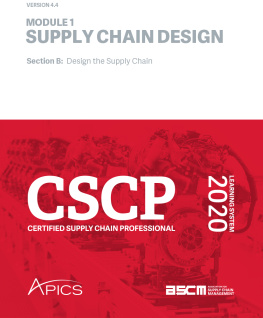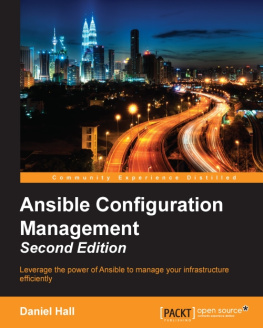APICS - CSCP 2020 Module 3 Section C
Here you can read online APICS - CSCP 2020 Module 3 Section C full text of the book (entire story) in english for free. Download pdf and epub, get meaning, cover and reviews about this ebook. genre: Business. Description of the work, (preface) as well as reviews are available. Best literature library LitArk.com created for fans of good reading and offers a wide selection of genres:
Romance novel
Science fiction
Adventure
Detective
Science
History
Home and family
Prose
Art
Politics
Computer
Non-fiction
Religion
Business
Children
Humor
Choose a favorite category and find really read worthwhile books. Enjoy immersion in the world of imagination, feel the emotions of the characters or learn something new for yourself, make an fascinating discovery.
- Book:CSCP 2020 Module 3 Section C
- Author:
- Genre:
- Rating:4 / 5
- Favourites:Add to favourites
- Your mark:
- 80
- 1
- 2
- 3
- 4
- 5
CSCP 2020 Module 3 Section C: summary, description and annotation
We offer to read an annotation, description, summary or preface (depends on what the author of the book "CSCP 2020 Module 3 Section C" wrote himself). If you haven't found the necessary information about the book — write in the comments, we will try to find it.
CSCP 2020 Module 3 Section C — read online for free the complete book (whole text) full work
Below is the text of the book, divided by pages. System saving the place of the last page read, allows you to conveniently read the book "CSCP 2020 Module 3 Section C" online for free, without having to search again every time where you left off. Put a bookmark, and you can go to the page where you finished reading at any time.
Font size:
Interval:
Bookmark:
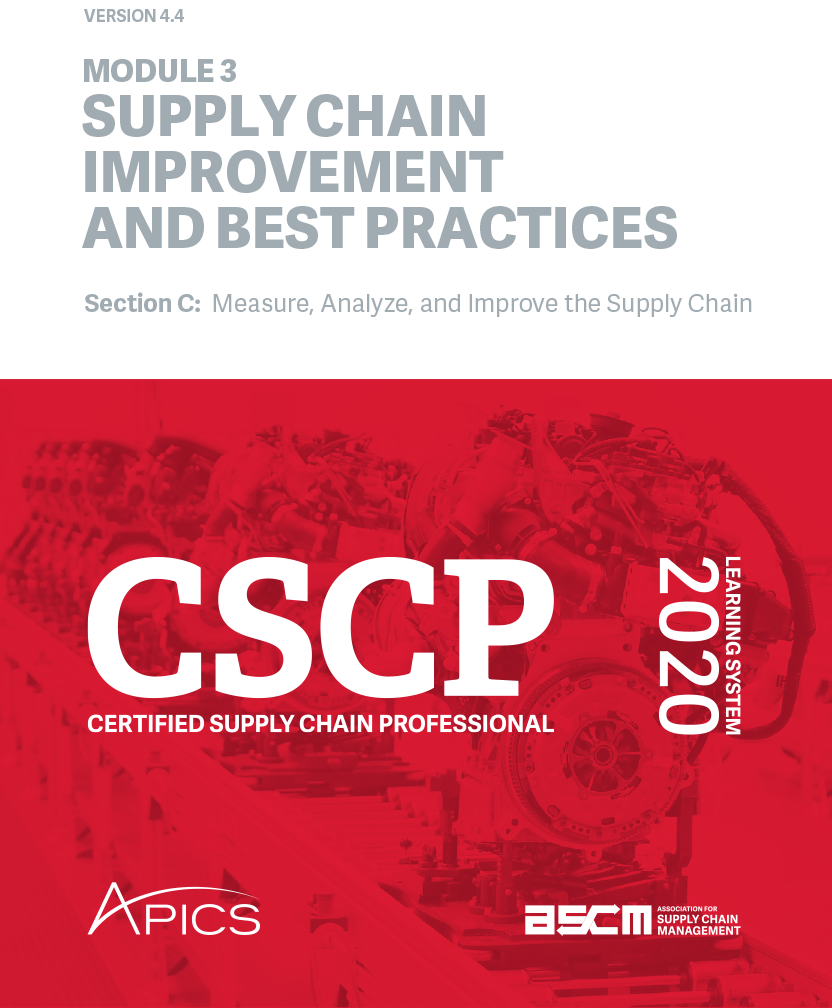
This section looks at the need for measurement and feedback in any supply chain, not only to continuously improve systems for greater efficiency and effectiveness but also to allow the systems to adapt to change. The discussion highlights the need to select measurements that will give proper incentives to the parties being measured, and then it looks at examples of customer-focused, financial, and operational metrics for the supply chain. A number of continuous improvement philosophies such as lean, six sigma, the theory of constraints, and total quality management are in this section to show how continuous improvement can be embraced systematically. Since initiatives such as these can fail to take hold unless brought in to the organizations culture, change management is the last subject of discussion.
All along the supply chain, managers are responsible for measuring results and ensuring that theyre on target to meet their functional goals as well as support the organizational and strategic plans. These plans may involve some form of continuous improvement initiative, so this section also discusses a number of ways to revolutionize your supply chain. Getting these things to move from plans or project to reality is often a challenge, so change management is addressed at the end of this section to ensure that the culture and operating practices sustain the desired initiatives.
The key processes that supply chain managers need to be able to perform related to measuring, analyzing, and improving the supply chain are
Gathering performance data
Analyzing performance
Improving performance.
Each of these processes is introduced next. Note that these are general overviews. The information required to plan and execute these processes is presented later in this sections topics.
Prerequisites to these processes involve setting measurement system objectives and planning what to measure:
Determining organizational objectives and how to measure and incentivize their success
Selecting metrics that are meaningful and promote desired behavior, yet are feasible and cost-effective to measure
The process of gathering performance data involves the following steps:
Determining the data to be collected as inputs to chosen metrics
Finding source(s) for the necessary dataincluding allowed external sources (e.g., reporting agencies, suppliers)
Assessing data collection feasibility; for example, for customers/suppliers:
Assessing availability, quality, and cooperation levels
Planning and executing data collaboration projects when feasible
Finding alternative data sources (i.e., proxies) as needed
Assessing data accuracy impact (e.g., distance-based freight rates might be used unless actual freight rates would significantly improve decisions)
Choosing the method of gathering each type of data (e.g., manual estimate, manual measurement, automated information system)
Determining the method of reporting the data (e.g., who, how, what, and when for manual or what events trigger automatic submission)
Setting up these processes and systems as needed (e.g., using projects)
Gathering and submitting data during normal operations
Entering manual data in information systems/tools in the proper format and using controls to minimize data entry errors
Validating data for relevance, reliability, and accuracy (e.g., compare to historical data to see if wide discrepancies exist; if so, investigate)
Archiving the data in a role-restricted repository (database) for ease of access and reference by appropriate parties
For example, performance data could be shipping and arrival dates, percent completion of a manufacturing process, number of defects, actual costs, and so on.
In another example, financial data for suppliers might include information directly from suppliers and/or their publicly available financial statements but also data from credit reports, bank references, or third-party ratings such as Moodys ratings, Fitchs ratings, or Dun & Bradstreet reports.
The process of analyzing performance involves the following steps:
Formulating questions that the performance information or model outputs should be able to answer
Turning data (raw observations and measurements) into information:
Placing it in context (e.g., comparing to baselines, goals, benchmarks, or past results)
Using the data as inputs for ratio analysis, formulas, or models
Using the data for comparisons across supply chain organizations to see if there is a net improvement for all
Validating information and tools for relevance, reliability, and accuracy (i.e., compare ratios to historical ratios or use historical data in models)
Making interpretations (e.g., viable options, status, trends, or forecasts)
Selecting formats and media appropriate to the information and audience
Preparing reports at predetermined intervals and on request
Presenting reports
Performance information might include shipment status, fill rate, on-time delivery variance, forecasted number of quality rejects, and so on. Reports can take the form of dashboards, regular status reports, updates, recommendations, formal presentations, and so on.
The process of improving performance involves the following steps:
Accepting feedback from decision makers and supply chain participants
Preparing recommendations for short-term or incremental improvement
Enacting approved short-term or incremental changes
Periodically auditing processes (including the measurement process itself) against strategic or long-term objectives
Preparing recommendations for changes to processes or metrics that better align with strategic or long-term objectives
Preparing recommendations as needed for making continuous improvement become part of the organizations philosophy (e.g., lean, six sigma)
Using change management and/or project management to enact strategic or long-term improvements to processes or performance
This chapter is designed to
Describe supply chain metrics and the process for selecting them
Describe customer-focused metrics and how they can be used to improve overall satisfaction
Explain the metrics used for measuring operations within the supply chain
Review the types of financial metrics used to measure supply chains.
The basic objectives of any measurement system are as follows:
Monitoring. Track actual system performance by observing and gathering data that is relevant to business objectives.
Controlling. Compare data to appropriate standards for performance to determine when the system needs modification or attention, identifying causes, and adjusting systems to get back on course or to continuously improve the course.
Font size:
Interval:
Bookmark:
Similar books «CSCP 2020 Module 3 Section C»
Look at similar books to CSCP 2020 Module 3 Section C. We have selected literature similar in name and meaning in the hope of providing readers with more options to find new, interesting, not yet read works.
Discussion, reviews of the book CSCP 2020 Module 3 Section C and just readers' own opinions. Leave your comments, write what you think about the work, its meaning or the main characters. Specify what exactly you liked and what you didn't like, and why you think so.

